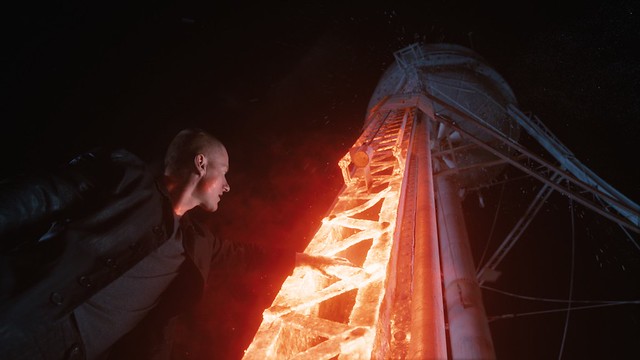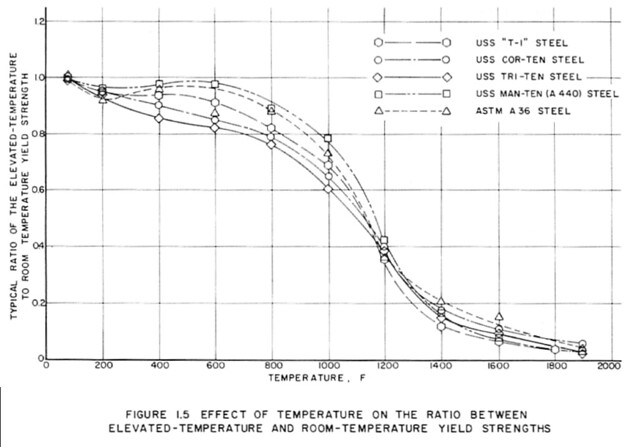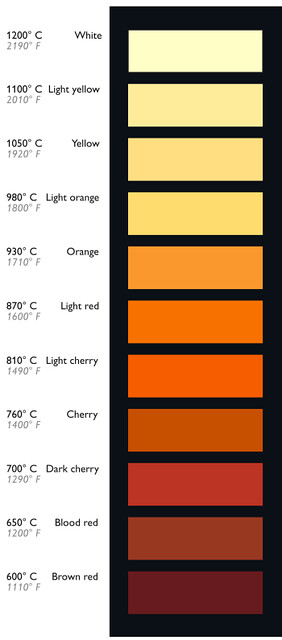Steel in Extremis
May 20, 2013 at 9:00 AM by Dr. Drang
I saw Iron Man 3 with my family Saturday night. It was fun (Ben Kingsley was especially good), but there was a part that bothered me a bit. I tweeted about it later:
Iron Man 3 was fun, but that water tower in Tennessee should’ve fallen long before its leg melted.
— Dr. Drang (@drdrang) Sat May 18 2013 8:56 PM CDT
The tweet got a little attention, so I figured it was worth explaining.
The scene I’m talking about is when Tony Stark is in Tennessee, trying to repair his suit and learn about the first Extremis explosion. After he escapes from the fight in the bar, Tony comes across Killian’s number one henchman who, in that way comic book villains have of being way too elaborate in their plans to kill the hero, melts one leg of the town’s water tower to bring it down onto Tony.
Here he is heating up the leg (big props, by the way, for using a laced design for the column):
And here he is “pulling” it down after the leg is so hot it’s almost dripping:
Both screenshots from fxguide.com.
The problem is that the leg would have failed long before it got to that orangey yellow state. Even though it doesn’t melt until about 2500° F, steel just isn’t very strong above 1000° F.
Here are a couple of charts showing the rapid dropoff of steel’s strength and stiffness (modulus of elasticity) for temperatures above 500°—700°. They’re taken from Brockenbrough and Merritt’s Structural Steel Designer’s Handbook.
These are idealized curves for design purposes, so they’re a little on the conservative side. I have an older version of this book that had a similar chart for strength with actual data points for different structural steels.
For completeness, I’ll mention that an older water tower like the one in the movie would almost certainly be made from A36 steel.
As you can see, somewhere between 1200° and 1300°, the strength of steel is about a third of its room temperature strength. Given that the water tank in the movie was full (it wouldn’t have been interesting otherwise), losing two-thirds of its strength and a similar amount of its stiffness
What color does steel take on a various temperatures? Here’s a handy chart from Swedish steel maker, Uddeholm:
At the temperatures needed to cause collapse, the steel would be only a dull red, not the bright orange and yellow we see in the film.
And in case you’re wondering, yes, pretty much all of the above went through my head as I watched that scene. “Bothered” may be too strong a word for my reaction, but I couldn’t help but notice it. We all have areas of specialized knowledge that get triggered when we see someone get it wrong. This is one of mine.
Why does a column collapsing at the wrong temperature tweak me more than a guy melting steel by touching it? Well, the Extremis stuff is part of the comic book universe; it’s one of the futuristic/fantastic elements that drive the story. Complaining about it would be like rejecting The Lord of the Rings because hobbits don’t really exist. The water tower, on the other hand, is part of our world and should act like it. It wasn’t designed by Tony Stark.
-
The stiffness is important because the leg is a compression member. Compression members fail by buckling, and buckling capacity is governed by both yield strength and modulus of elasticity. The more you know… ↩





